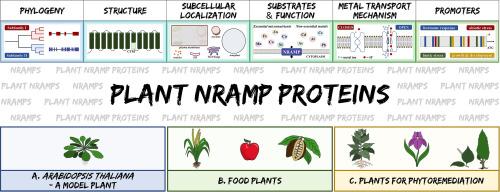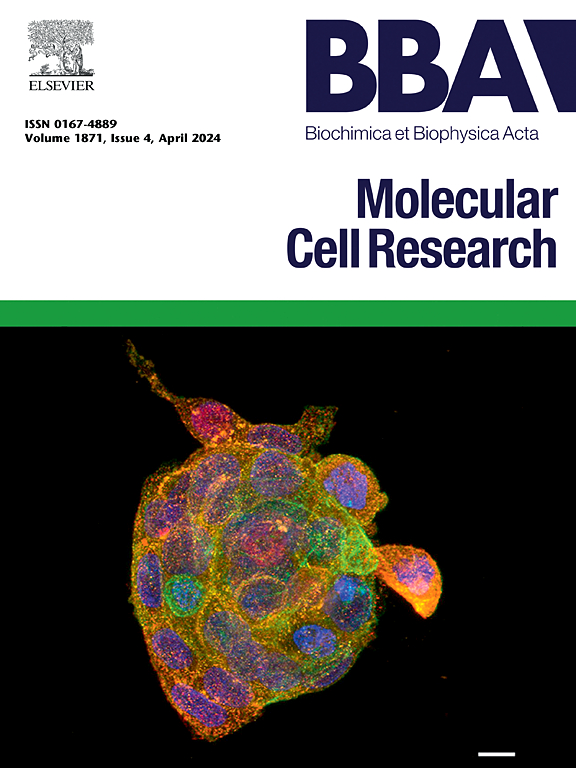NRAMP family in plants: Contribution to cadmium accumulation
IF 3.7
2区 生物学
Q1 BIOCHEMISTRY & MOLECULAR BIOLOGY
Biochimica et biophysica acta. Molecular cell research
Pub Date : 2025-09-04
DOI:10.1016/j.bbamcr.2025.120056
引用次数: 0
Abstract
The Natural Resistance Associated Macrophage Proteins (NRAMPs) are membrane-targeted transporters with low substrate specificity, that mediate the import (translocation to the cytoplasm) of metals, mainly essential nutrients, e.g. iron (Fe), manganese (Mn), zinc (Zn), cobalt (Co), copper (Cu) or nickel (Ni). Depending on the subcellular localisation, they contribute to either uptake or redistribution. Numerous studies have shown that NRAMP proteins also mediate the transport of non-essential toxic metals, and constitute the major pathway for the uptake of cadmium (Cd) in plants. Given the threat to living organisms from exposure to this toxic metal, which enters the food chain through edible plant parts, this review focuses on how different NRAMP proteins are involved in Cd uptake and accumulation. The issue was discussed concerning three categories of plants: (i) the model plant Arabidopsis thaliana; (ii) crop plants that are mainly used for food; (iii) plant species used for the phytoremediation of Cd-polluted environments, including hyperaccumulators. For the sake of clarity, this paper updates the structure, function and regulation of NRAMP genes and proteins, their phylogenetic relationships, and their substrates, filling a knowledge gap, and discussing these topics in light of new data. Furthermore, this review discusses the potential applications of NRAMP genes in plant biotechnology, such as generating low-Cd food and phytoremediation.

植物NRAMP家族:对镉积累的贡献。
天然耐药相关巨噬细胞蛋白(NRAMPs)是一种低底物特异性的膜靶向转运蛋白,介导金属的进口(转运到细胞质),主要是必需营养素,如铁(Fe)、锰(Mn)、锌(Zn)、钴(Co)、铜(Cu)或镍(Ni)。根据亚细胞定位的不同,它们有助于摄取或重新分配。大量研究表明,NRAMP蛋白还介导非必需有毒金属的转运,并构成植物吸收镉(Cd)的主要途径。鉴于暴露于这种有毒金属对生物体的威胁,这种金属通过可食用的植物部分进入食物链,本综述侧重于不同的NRAMP蛋白如何参与Cd的吸收和积累。讨论了三类植物的问题:(1)模式植物拟南芥;(二)主要用于食用的农作物;(iii)用于cd污染环境的植物修复的植物物种,包括超积累植物。为了清晰起见,本文更新了NRAMP基因和蛋白的结构、功能和调控、它们的系统发育关系以及它们的底物,填补了知识空白,并结合新的数据对这些主题进行了讨论。此外,本文还对NRAMP基因在低镉食品生产和植物修复等植物生物技术方面的潜在应用进行了综述。
本文章由计算机程序翻译,如有差异,请以英文原文为准。
求助全文
约1分钟内获得全文
求助全文
来源期刊
CiteScore
10.00
自引率
2.00%
发文量
151
审稿时长
44 days
期刊介绍:
BBA Molecular Cell Research focuses on understanding the mechanisms of cellular processes at the molecular level. These include aspects of cellular signaling, signal transduction, cell cycle, apoptosis, intracellular trafficking, secretory and endocytic pathways, biogenesis of cell organelles, cytoskeletal structures, cellular interactions, cell/tissue differentiation and cellular enzymology. Also included are studies at the interface between Cell Biology and Biophysics which apply for example novel imaging methods for characterizing cellular processes.

 求助内容:
求助内容: 应助结果提醒方式:
应助结果提醒方式:


